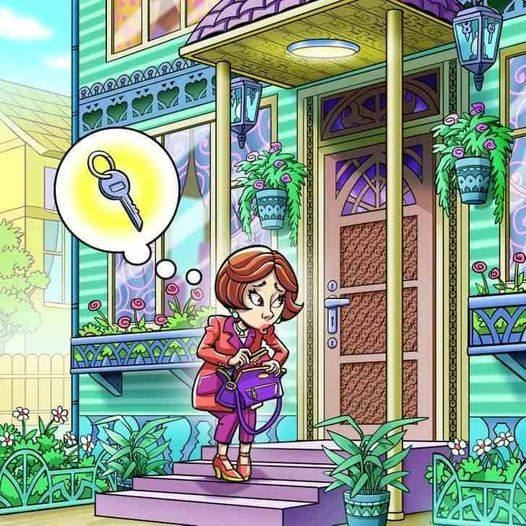Optical illusions are fascinating puzzles that challenge the way we see the world, often revealing more about our brain’s processing than we realize. These mind-bending images force us to scrutinize details we would usually overlook, enhancing our cognitive skills and sharpening our memory. Engaging with such puzzles regularly can even boost creative thinking and problem-solving abilities.
Solution is at the end of the article
One such challenge involves an image where a woman is searching for her house key. She is depicted standing outside her home, frantically rummaging through her purse. The catch? The key isn’t in her purse at all. It’s hidden somewhere within the image, and your task is to find it within seven seconds. This puzzle is a great test of your visual acuity and observation skills. Those with a sharp eye might catch the key right away, but for others, it might take a bit longer.
When facing an optical illusion like this, the key is to scan the image carefully. It’s easy to get distracted by the obvious, like the woman’s purse or the door, but the solution often lies in the less conspicuous areas. Have you managed to find the hidden key yet? If you’re struggling, don’t worry—these puzzles are designed to be challenging, and sometimes it takes a few tries to see through the illusion.
For those who couldn’t spot the key within the time limit, here’s the solution: the key is hanging from the lamp post in the top right corner of the image. It’s a tricky spot that many overlook on the first glance, but once you see it, it seems so obvious. This exercise demonstrates how easily our brains can be misled by focusing on what we expect to see rather than what’s really there.
These types of visual challenges aren’t just fun—they’re also a great way to keep your mind sharp. By regularly engaging in activities that test your observation and problem-solving skills, you can enhance your cognitive abilities and even improve your memory. Whether it’s spotting hidden objects in a picture or solving a complex puzzle, these exercises stimulate your brain and keep it in top form.
In addition to being a fun way to pass the time, optical illusions like this one can also be used as educational tools. Teachers and parents can use them to encourage critical thinking in children, helping them learn to look beyond the obvious and consider alternative possibilities. This type of thinking is essential in problem-solving and can be applied to many different areas of life, from academics to everyday decision-making.
If you enjoyed this challenge, you’re not alone—optical illusions have been captivating people for centuries. They tap into our natural curiosity and our desire to solve problems, making them a popular form of entertainment. In today’s digital age, these puzzles have found a new life online, where they are shared and enjoyed by millions around the world.
So next time you come across an optical illusion, don’t just glance at it—take a moment to really look. You might be surprised at what you discover. And remember, the more you practice, the better you’ll get at spotting the hidden details that others might miss.
If you found this puzzle intriguing, share it with your friends and family to see how quickly they can find the hidden key. Who knows? You might discover that you have the sharpest eyes in the group. And if you didn’t spot the key this time, don’t be discouraged—just keep practicing, and you’ll soon be solving these puzzles with ease.
Optical illusions are more than just a passing amusement—they’re a way to challenge your mind, improve your cognitive abilities, and see the world in a new light. So next time you’re faced with a tricky image, take a deep breath, focus, and see if you can find what’s hidden within.


